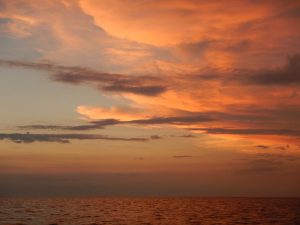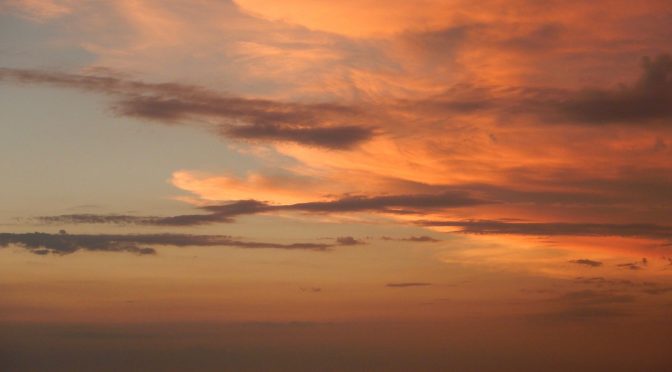 The sky over our last night in Belize. Once again, this photo is NOT color corrected!
The sky over our last night in Belize. Once again, this photo is NOT color corrected!
Now that I’ve been back from Belize for a few days, I’ve had some time to gather my thoughts on the past two weeks. I had the privilege of visiting two of the world’s most biologically diverse ecosystems and witnessing their beauty firsthand. Although the rainforest and the reef seem to be completely distinct ecosystems, in reality, they have several underlying similarities.
The biggest concept I learned about these two ecosystems on my trip was that both exist in oddly nutrient-poor areas. You’d think that such diverse places would never be able to survive in environments as lacking in nutrients as the soil of the Chiquibul or the waters of Glover’s Reef. But paradoxically, they thrive here!
Upon closer inspection, the “paradoxes” of the rainforest and of the reef aren’t paradoxes at all. In both ecosystems, the efficient recycling of nutrients allows these areas to support such a large diversity of organisms. So even though the soil or the water itself may be nutrient-poor, these ecosystems are able to flourish.
Even at first glance, I noticed similarities between the rainforest and the reef. I was impressed by the sheer diversity of animals in both places. Even without going anywhere, I observed more life than I’ve ever seen back home in Texas. At Las Cuevas, hundreds of species of moths, as well as frogs, geckos, katydids, and scorpions clung to the station walls every single night. It was the same at Middle Caye at Glover’s Reef. I spotted multitudes of fish, including barracuda, sardines, lemon sharks, and nurse sharks from the dock of the island. We also shared the island with hundreds of hermit crabs, iguanas, and blue land crabs. It’s crazy how the animal life in both places came to us without us even having to seek it out.
Belize was everything I expected and more. I’m rereading my pre-trip blog now, and it’s comical to me how accurate my expectations for the trip were. Two weeks ago, I said I expected a lot of sweat and longing for air conditioning – and I was SOOO right. I don’t think I was completely dry for a single minute on the entire trip – I was always either sweaty or in the ocean.
The painfully early mornings and physical tiredness from full days of hiking or swimming were probably my least favorite aspects of the course, but even those I didn’t mind too much. (Actually, maybe finding bug bites in places where I never, EVER wanted to find bug bites was my least favorite thing. Anyway.) They were necessary for us to make the most of our time in Belize.
It’s so difficult to choose only one or a few favorite parts of the trip because I genuinely enjoyed every single day – who wouldn’t? I got to wake up in some of the most beautiful places in the world for two weeks. Like, what the heck?? But if I had to pick, my favorite moments of the trip were either checking the contents of our camera traps, collecting sea urchins, or swimming at the reef crest.
I’ll never forget the moment we saw a tapir captured in the lens, which was then followed by jaguars, pumas, armadillos, and more! We probably screamed loudly enough to wake up the whole research station. I also had a real ball finding and catching sea urchins. They were in my taxon, after all, and they were so fun to spot! It was basically iSpy, but in the name of science. And how could I not love the reef crest? I’ve never seen such extraordinary abundance of life anywhere.
In the end, believe it or not, this trip was actually a class and not a vacation. That means that I actually learned stuff and didn’t sit around drinking and eating fresh coconuts on the beach all day – although there was some of that, too. I learned a lot about the lives of real TFBs and commonly used techniques in the field. Some of these techniques include taking transects (taking measurements at set increments of distance along a straight line), using quadrats (using grids to count items of interest), and setting pitfall and camera traps. We conducted several mini-projects over the course of the trip in which we practiced using some of these techniques.
Something else that I learned about that will stick with me for a long time is not only the danger that both forests and reefs face, but also about the efforts of those who fight against these dangers. For example, the FCD, Friends for Conservation and Development, is an NGO made up of a few dozen men who patrol the forests of Belize. They also speak with the national government and mediate political conflicts that bleed over into the environment. Basically, they do jobs that seem to be meant for a government to do, and they do them well.
And finally, I learned a lot about myself. I learned that I’m not as much of a wimp as I thought I was. Sure, I’m not the most athletic person you’ll ever meet, but I can keep up on difficult hikes and I can swim through strong currents. I learned that I have a knack for spotting and catching critters, and that I’m not creeped out by creepy crawlies. In fact, I actually really enjoy them! (Unpopular opinion – millipedes are pretty cute.) And most importantly, I really, really love the TFB life. I’ll never be Steve Irwin, but now I can say that I’m a certified Tropical Field Biologist.
Feels great.

